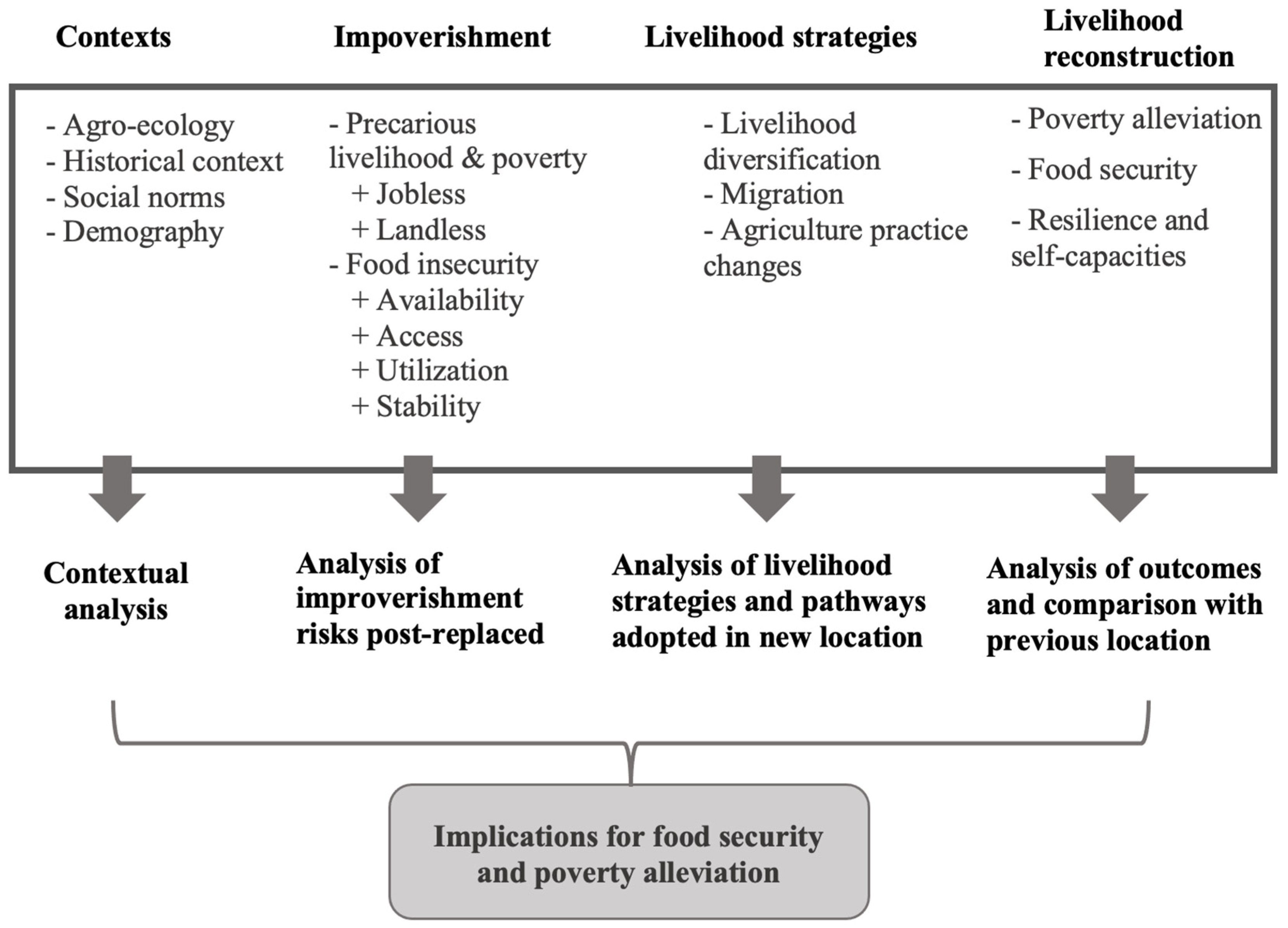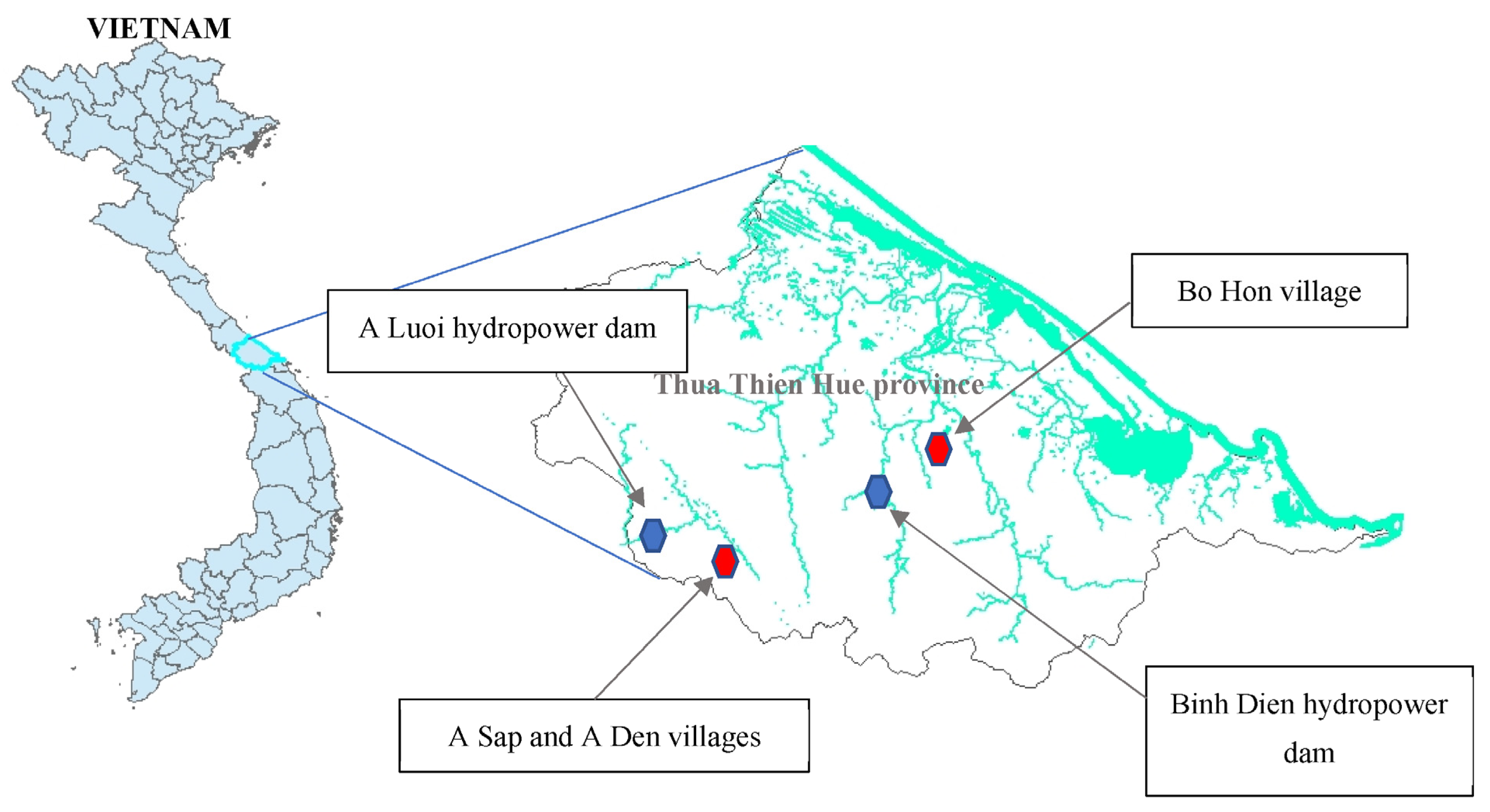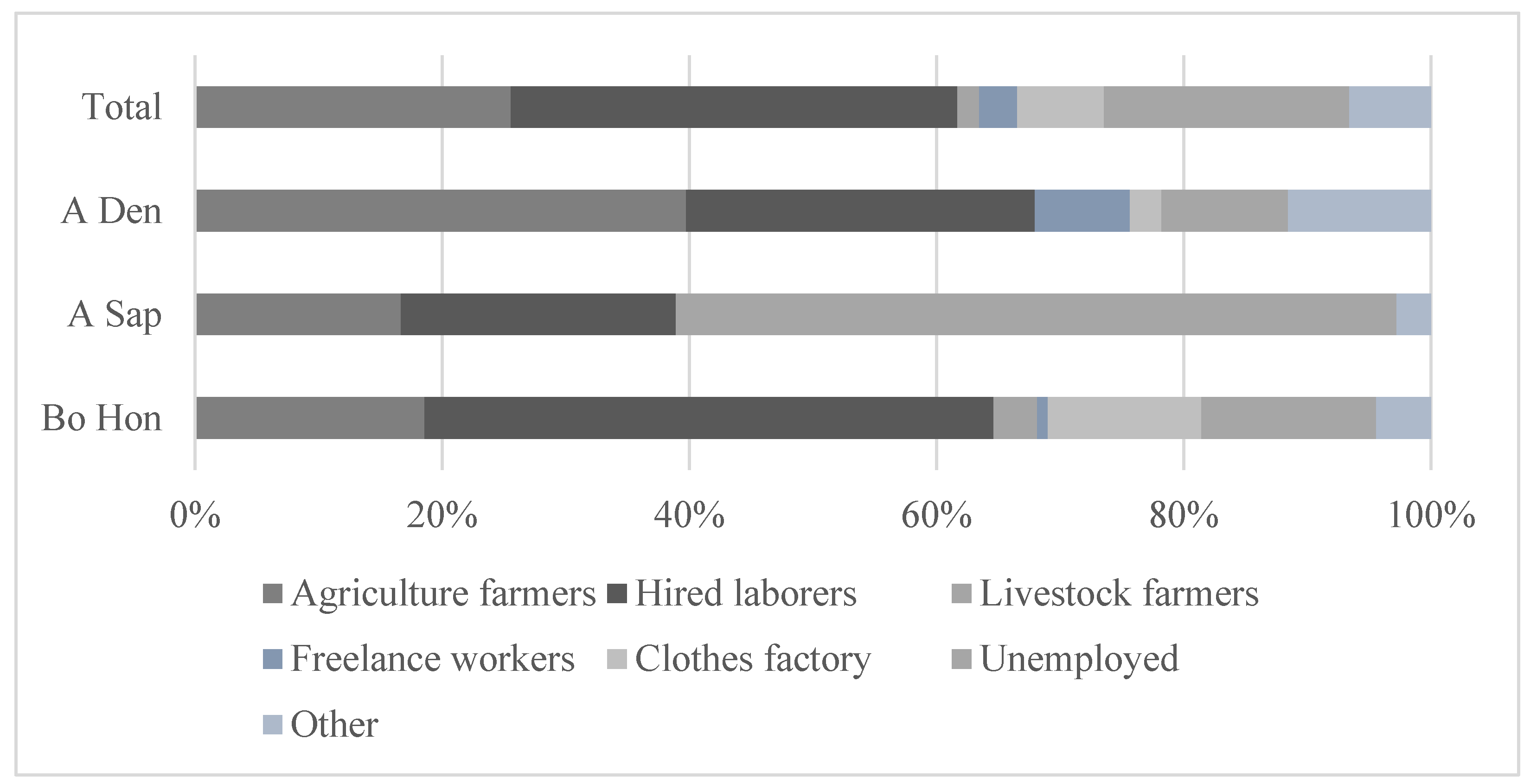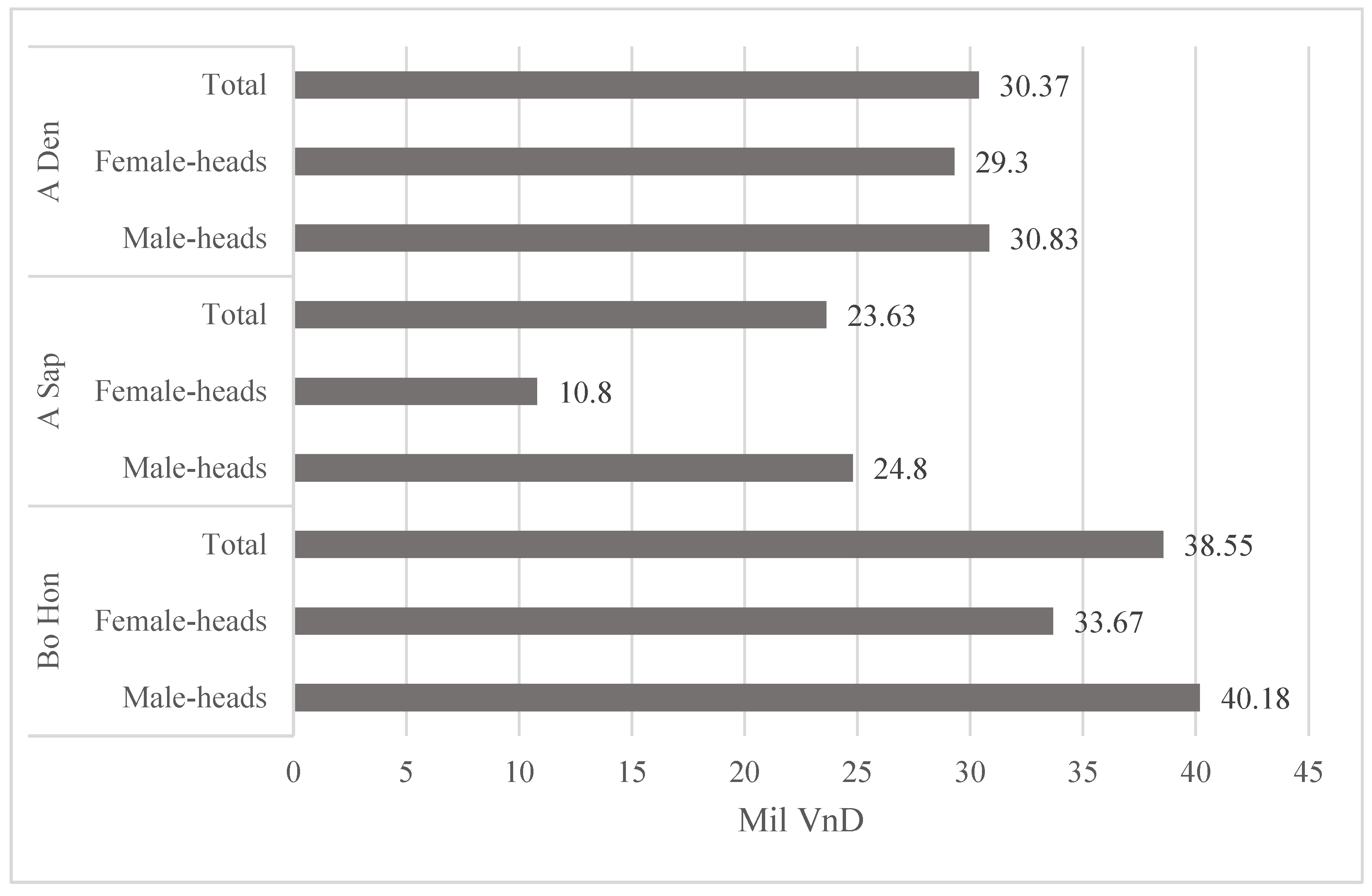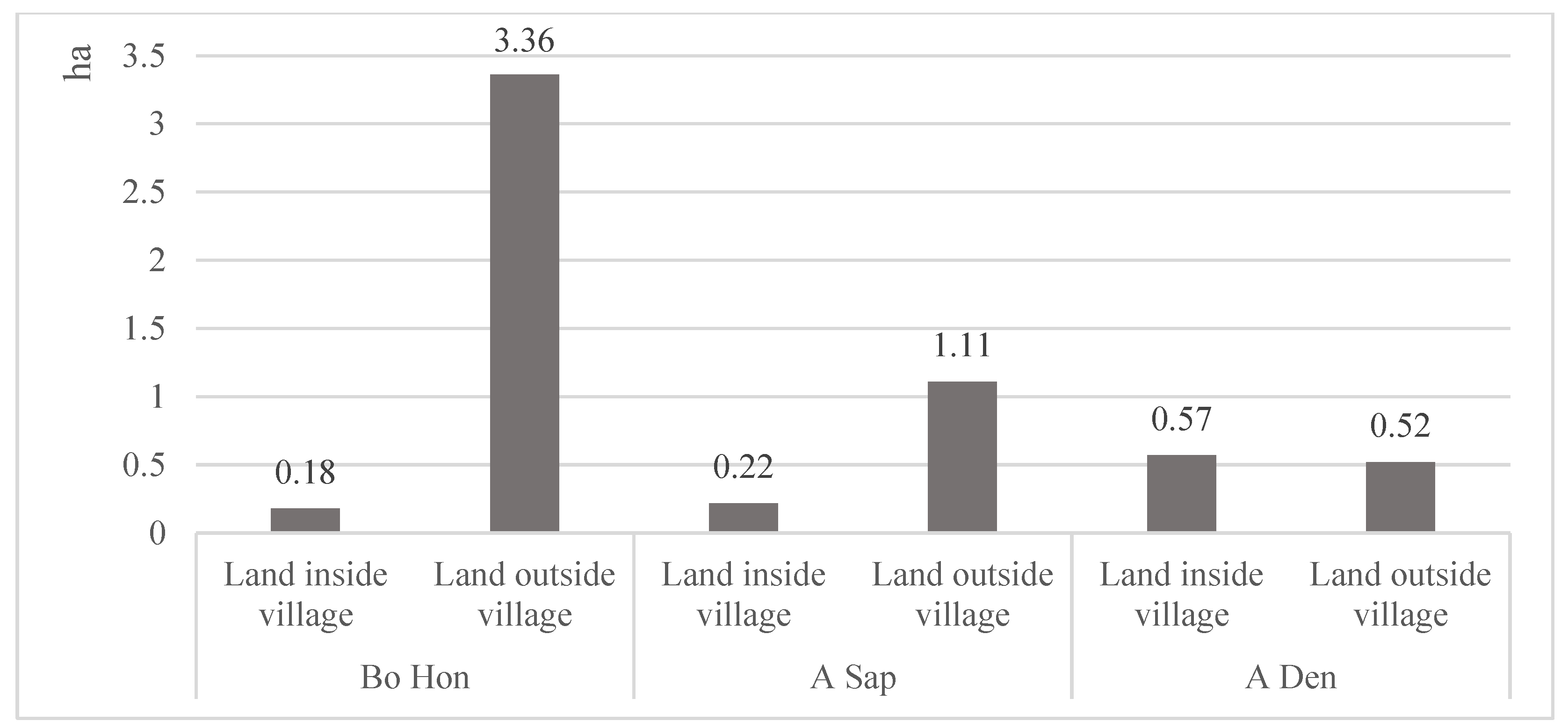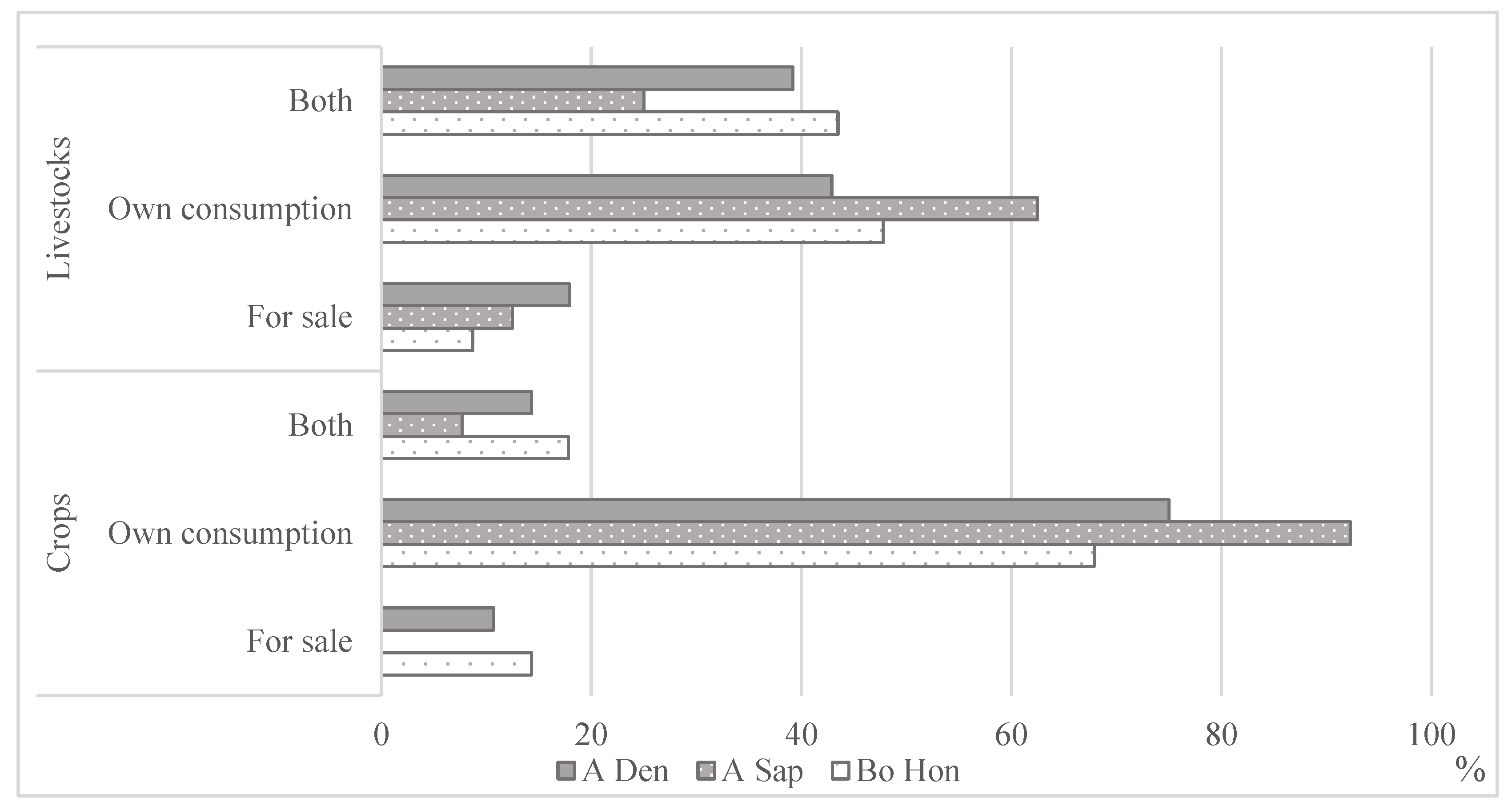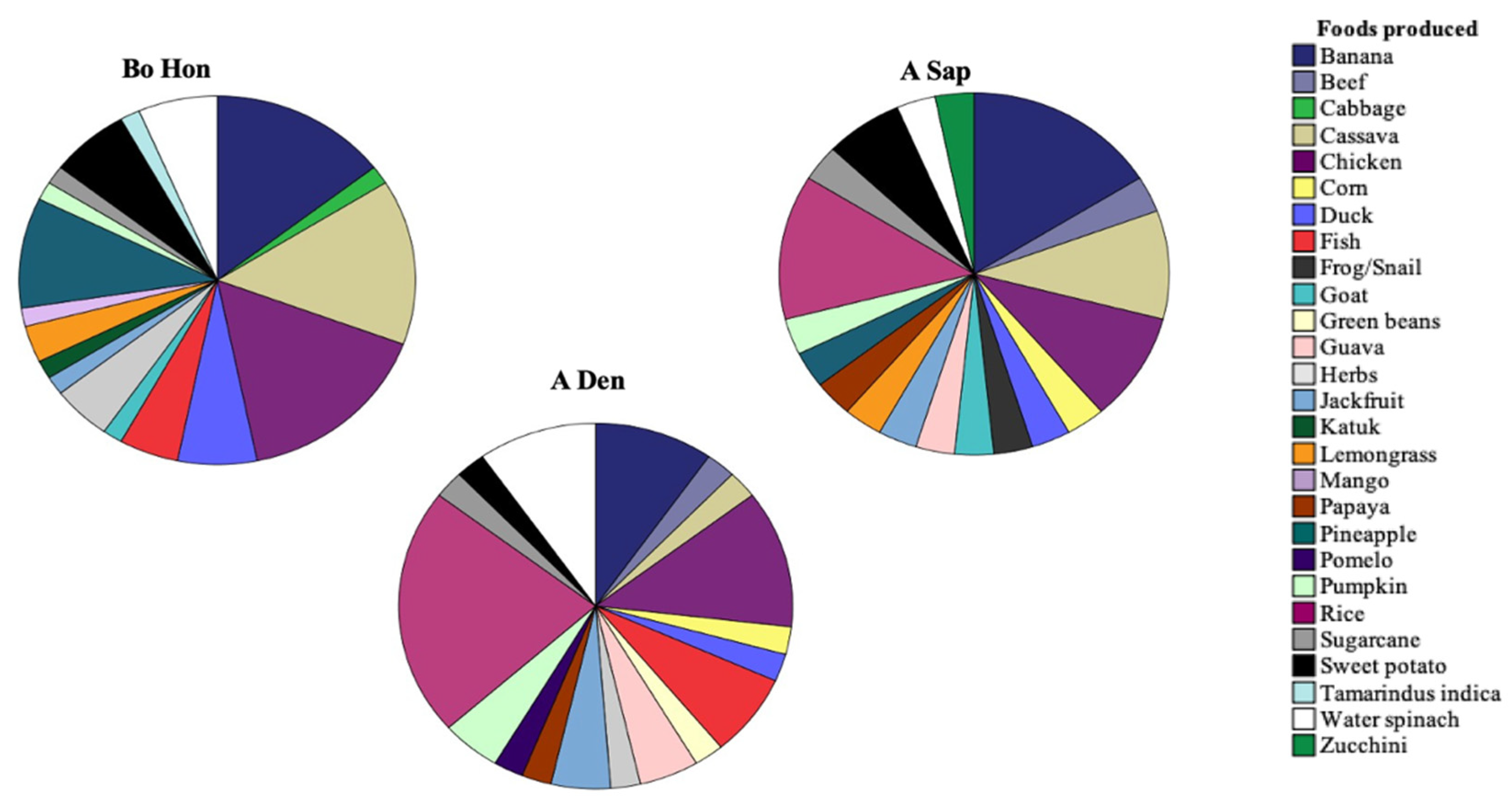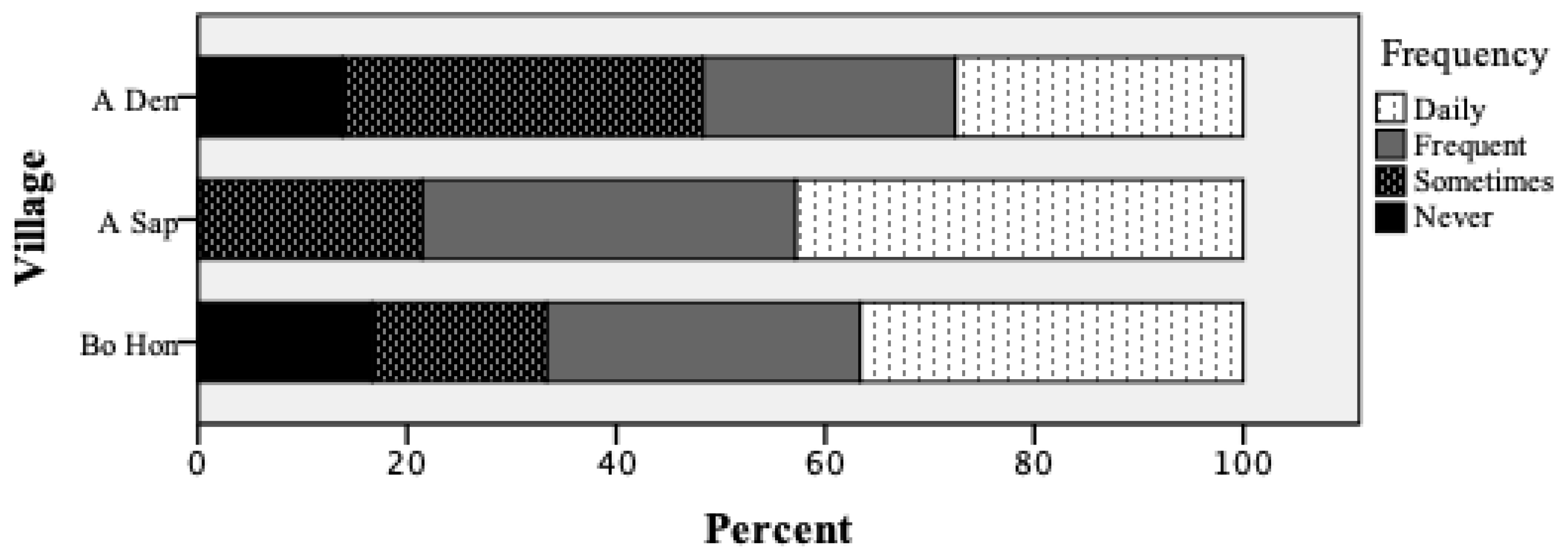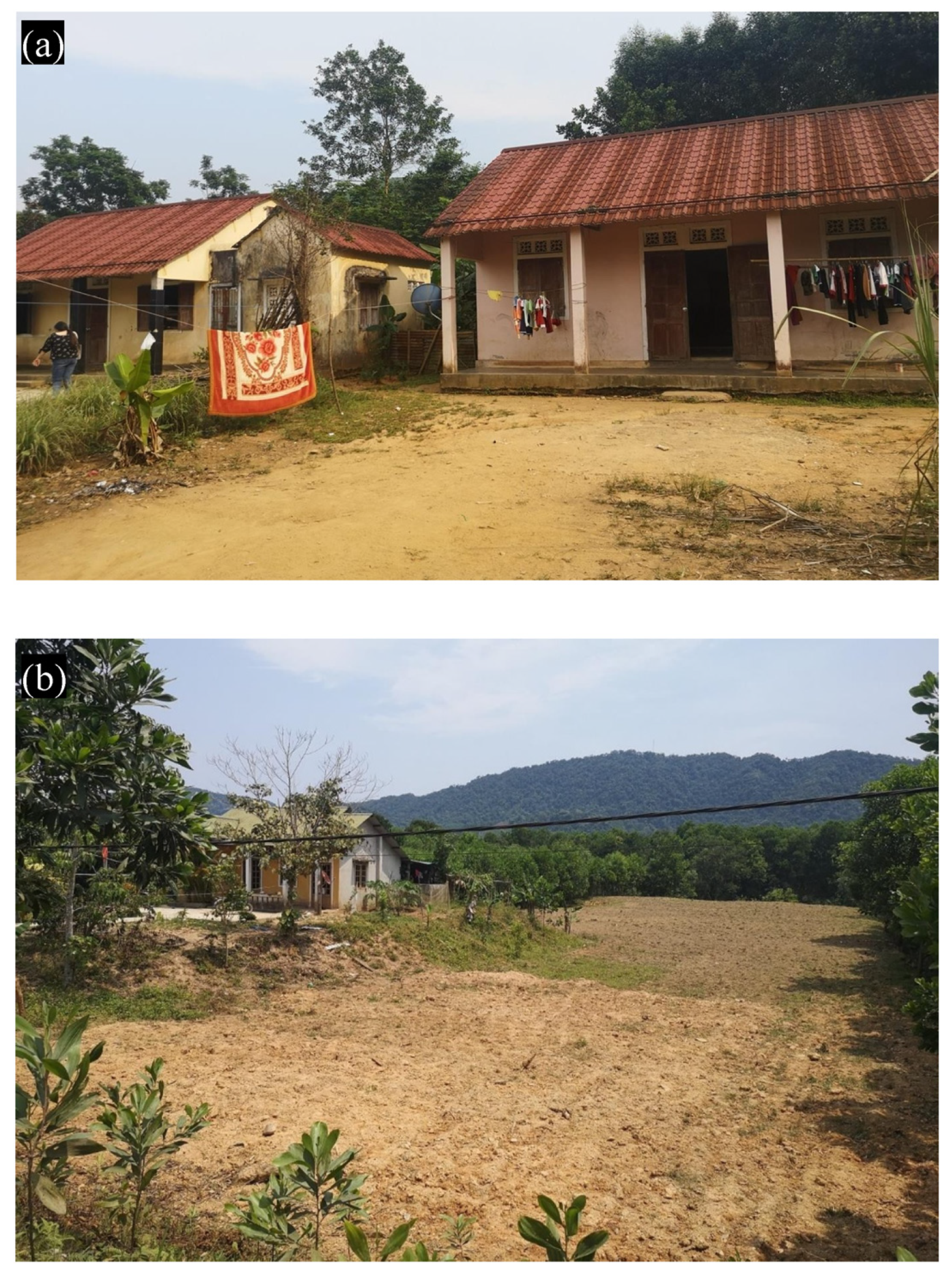1. Introduction
Over the past three decades, Vietnam has undergone a rapid transformation from an impoverished nation to a flourishing middle-income country. This transformation was initiated in 1986 through the implementation of “Đổi Mới” economic policies, which aimed to establish a socialist-oriented market economy. As a result, the development of hydropower dams in Vietnam has experienced substantial growth in recent years in order to meet the rising energy demand (
Hill et al. 2017;
Ty et al. 2011; H. T.
Nguyen et al. 2017). Hydroelectricity is a crucial component in the energy production sector and also serves as an efficient means of flood control and drainage in Vietnam for agriculture. It is considered a clean source of energy as it generates electricity through the movement of water without the combustion of fossil fuels, leading to minimal environmental emissions (H. T.
Nguyen et al. 2016). With the increasing concern over global warming, hydropower is viewed as a sustainable resource for the world’s energy needs and is recognized as a clean development mechanism that utilizes natural resources (
Nhung 2017). Given the abundance of river systems in Vietnam, hydropower development has become a pivotal aspect of the country’s economic development strategy. As of 2021, there are 818 hydropower projects in Vietnam with a total potential capacity of 23,182 MW. Out of these, 385 power projects have been operationalized with a total capacity of 18,564 MW, 143 projects are currently underway, and 290 projects remain in the planning phase (
EVN 2019). Approximately 27% of these hydropower projects are located in Central Vietnam. In 2014, hydropower accounted for approximately 32% of the country’s total national electricity production. According to the Power Master Plan 2030 forecast, the proportion of hydropower is expected to remain significant, at 23% (
EVN 2017).
While hydropower dams provide benefits, the construction of such dams also comes with unavoidable consequences, such as the displacement of communities, the loss of livelihoods, social disruption, and a reduction in living standards. Over 200,000 Vietnamese people have been displaced as a result of hydropower projects in the past decades, leading to poverty, food insecurity, and increased morbidity (
Bui and Schreinemachers 2011;
Ty et al. 2013). The adverse impacts of hydropower dam construction on local communities have attracted criticism from both domestic and international scholars. For instance,
Nhung (
2017) conducted a case study in Quang Nam province and found that hydropower development in the Gia Vu-Thu Bon River basin led to insufficient and delayed compensation, a loss of forestland, and water-related risks such as drought and flooding (
Nhung 2017). Similarly, H. T.
Nguyen et al. (
2017) analyzed the impacts of displacement and resettlement on rural livelihoods and daily life and found that it reduced land area for profitable commodities and traditional income sources, leading to poverty and migration (H. T.
Nguyen et al. 2017). Other studies have documented land ownership conflicts between locals and hydropower companies (
Ty and Nghi 2017), social and gender issues, water and food security, and the structure of local livelihoods (
Hill et al. 2017;
Nhung 2017;
Huu 2014;
Ty et al. 2011; H. T.
Nguyen et al. 2017;
Van Huynh et al. 2019). The potential benefits of hydropower projects must be weighed against the risks of displacement and associated adverse impacts when evaluating the overall impact of hydropower development on the nation.
The existing literature on the sociological impacts of hydropower development and resettlement programs in Vietnam has a narrow perspective, with a focus on short-term assessments of changes in livelihood, and a lack of intersectional analysis. This has resulted in an incomplete understanding of the intricate connections between poverty, gender, cultural norms, and social factors in the context of resettlement. Despite the abundance of research in this field, the question of how impoverishment risks arise, and how they can be prevented, remains unanswered (
Koch-Weser and Guggenheim 2021;
Pierotti 2011;
Cernea 2002). In light of this, there is a critical need for further examination of the long-term effects of hydropower-induced displacement on livelihood development and food security in resettled communities in Vietnam. This study takes a sociological approach to fill this gap in knowledge, exploring the impacts of hydropower-induced displacement over a period of 10 years in Thua Thien-Hue province. The objectives of the present study are to (1) compare the livelihood and food security of displaced households before and after resettlement; (2) identify livelihood challenges and root causes arising from the resettlement process; (3) examine the coping and adaptation strategies employed by the resettled communities; and (4) propose policy implications for promoting sustainable livelihood development and poverty alleviation.
By doing so, this study aims to make a valuable contribution to the broader understanding of the socio-economic consequences of hydropower development and resettlement in Vietnam. The findings of this research have the potential to offer practical solutions to address the persistent impoverishment of affected communities, providing a more profound and novel perspective on this important issue.
4. Results
4.1. The Demographic and Contextual Analysis
The demographic profile of the surveyed households was analyzed to determine the distribution of various characteristics, such as ethnicity, gender, age, and education level.
Table 1 presents the findings of the demographic analysis. It was observed that the majority of households in Bo Hon village are of Ka Tu ethnicity (92.1%). The remaining households in the village are of Kinh origin, and they all reside in a close-knit community within the same area. In contrast, the A Sap and A Den villages are predominantly inhabited by Ta Oi ethnic people, accounting for 83.3% and 92.7%, respectively. No households of Kinh or Pa Co origin were identified in these two villages. However, an analysis of the data collected in 2019 showed that 7.3% of the households in A Den village are of Pa Co origin, which suggests that the division of Can Tom 2 village has resulted in the influx of households from other ethnic groups into the new A Den settlement. This can also be seen in A Sap, where 83.3% of the respondents are of Ta Oi origin. This redistribution of ethnic minority groups between the two villages is noteworthy, considering that five years prior, the Pa Co and Ta Oi peoples requested separate villages to maintain their own leaders and patriarchal systems due to a lack of social cohesion. These findings from A Den and A Sap provide important insights into the differences between the two villages and how their composition has changed over time.
To capture the evolving demographic characteristics of the villages more accurately, all households were categorized based on their household size. The majority of households in the villages had four members, including two parents and two children. In Bo Hon, young expanding families consist of families with children born after the resettlement in 2006, whereas in A Den and A Sap, these families have children born after the resettlement took place in 2011. In A Sap, most households are categorized as “families with a full nest.” Mature families, which consist of one or two parents with mature, working children, and households with migrated children, are also present. The results indicate that migration among the youth is most prevalent in Bo Hon, with 47% of the households having children who have migrated for job opportunities outside the village. In A Den, 40% of the surveyed households have children who have migrated, whereas in A Sap, the figure is 33%. Based on the research findings, it was observed that men participated in the interview more than women, with an average of 53.23% and 46.77%, respectively. This trend can be attributed to the fact that male-headed households make up a larger proportion than female-headed households. For instance, in Bo Hon village, out of the total of 54 households, 64.8% are headed by males. Consequently, during the random interview process, the percentage of men interviewed was significantly higher than that of women. However, it should be noted that men were often not present during the interview process as they may have been working outside the village or in the forest. Thus, the research team interviewed the women (wives) who represent the household. As such, the results indicate the percentage of men and women representing households and not necessarily the percentage of household heads. The majority of the population falls within the working age range of 18 to 65. Surprisingly, the illiteracy rate among household heads was found to be high, at 17.07%. The highest number of illiterate household heads was found in Bo Hon, at 24.6%, followed by A Sap, at 20.8%, and the lowest number was found in A Den, at 7.1%
4.2. Risks and Impoverishment Post-Resettlement
4.2.1. The Impoverishment Risk Related to Precarious Livelihood and Poor
- -
Jobs and income contribution
The availability of employment opportunities has a significant impact on the population composition and whether individuals choose to stay in the villages or pursue better job prospects elsewhere. Migration to Ho Chi Minh City, the largest city in Vietnam, is a common trend among the youth, both male and female, who secure work in clothing factories and shops, as well as hired or agricultural workers to a lesser extent (
Figure 3). The monthly income earned by migrants from Bo Hon is 3.5 million VND (n = 8), whereas in A Den, this figure is 4.7 million VND (n = 8). These amounts are relatively low, especially considering the demanding nature of overwork. One individual from Bo Hon reported that he returned to the village after working in Ho Chi Minh City for a year due to the excessive workload. Not all migrants earn enough to send remittances back home, with only 21% of Bo Hon households receiving an average of 41 million VND per year from their children. They are usually spent on purchasing clothing, covering expenses during the Tet Holiday, or repaying bank loans. The respondents stated that job opportunities in the area are limited, primarily consisting of work as hired laborers or farmers (
Figure 3). With unstable harvests and seasonal work, employment opportunities are inconsistent, leading many to work multiple jobs in parallel to earn a stable income. These additional jobs may include work on acacia plantations, land clearing, field tilling, hunting, livestock breeding, rice cultivation, or selling crops.
Figure 4 displays the average annual household income in million VnD, separated by the gender of the household head. Only a small number of households generate income from utilizing common property, with an average monthly income of up to 5 million VnD. For instance, three households from Bo Hon and A Den reported making bamboo hats and bamboo mats for sale. One of these households could earn 100,000 VnD per day from selling handmade bamboo hats, though the income from such activities is subject to fluctuations depending on the season. The results of an analysis of variance test indicate that there is no significant difference between the mean incomes across the villages (
p = 0.477). Results from a linear regression test suggest that the gender of the household head explains 95% of the variance in Bo Hon (
p = 0.658) and 23% of the variance in A Den (
p = 0.911). However, the results do not suggest a significant impact of the household head’s gender on the household’s income. In all three villages, at least one household does not earn an income. A woman from Bo Hon reported that she and her husband were unable to work due to illness and therefore no longer had an income. Their sons recently migrated to Ho Chi Minh City to work in a clothing factory, but they have not yet been able to send remittances. She now makes and sells bamboo hats as a short-term solution to buy food. Another woman from A Sap village in a similar situation reported selling her hair to pay for her family’s daily expenses.
- -
Land ownership and land use.
Most people in the villages earn a living through farming or hired laborers (working for others on plantations). The amount of income is closely tied to the size and quality of the land they own. As seen in
Figure 5, the average size of land owned by households varies between Bo Hon, A Den, and A Sap. A Kruskal–Wallis test revealed that there is no significant statistical difference (
p = 0.283) between the average size of land owned by households in the three villages. According to the village leader of Bo Hon, adequate land ownership is crucial for development in the area. Without land, it becomes difficult to grow cash crops or establish acacia plantations, which provide job opportunities. In Bo Hon, 70% of households grow acacia on their land, whereas the percentage is 40.7% in A Den. Additionally, households in Bo Hon also grow cassava and fruits, whereas cash crop production is more prevalent in A Sap. Livestock breeding has also become a significant use of land in all three villages, though not many people have separate spaces for it.
Living conditions in the villages vary. In Bo Hon, most families still live in small plots in houses provided by the hydropower company after resettlement. However, some young families have built their own wooden houses on family-owned plots. A few households in Bo Hon have larger houses as they opted for compensation money instead of a house for resettlement. In A Den and A Sap, houses are set up more spaciously, with more variety and more agricultural land. Some households even own small ponds for fish farming. In conclusion, land ownership plays a crucial role in determining the income and living conditions of households in the villages.
The major issue facing the resettlement villages is the inadequate quality of the agricultural land, leading to limited job opportunities, low income, and food insecurity. Almost all participants from the three villages reported the quality of their land as either “bad” or “very bad”. To improve crop growth, over 70% of them use either chemical or natural fertilizers. One woman from Bo Hon noted that the poor land quality is a persistent problem due to a rock layer beneath the soil. Meanwhile, drought, flash floods, and landslides in upland farms also contribute to the degraded land quality.
4.2.2. The Impoverishment Risk Related to Food Insecurity
As analyzed, food security includes four main aspects, namely, food readiness, food accessibility, food utilization, and food stability (
FAO 2006). In addition to examining these elements, this section will also present the Food Coping Strategies Index (FCSI), which is a critical tool for evaluating households’ food security (
Minaker et al. 2011).
- -
Food availability
Importing, supporting, stockpiling, and domestic food production are closely related to a country’s food availability (
FAO 2006). In the resettled villages, limited land area and poor soil quality have made it difficult for many displaced households to produce enough food for themselves. Most of the resettled households cultivate crops for self-sufficiency; however, they cannot identify the food they produce because the yield is little or seasonally unstable. The production of food to feed their families is an important concern for them (
Figure 6). In the resettled villages, only a few well-off families with large land areas can produce food for sale. In order to earn additional income in cash, most of the resettled households practice small-scale livestock farming such as raising chickens in A Den village, and more than 50% of the surveyed households own at least one cow.
Figure 7 illustrates the types of food produced for self-consumption. The most common foods grown are chicken, bananas, and cassava. Rice is a popular crop in A Den and A Sap, whereas raising chicken and growing cassava and pineapple is more prevalent in Bo Hon. There is a wide range of foods produced by the villagers, and they strive to make the most use of edible products, as evidenced by the use of leaves from sweet potatoes and banana trees in Vietnamese diets. According to the results of FGDs (2019), the quality of food in the new Bo Hon settlement has declined, but the variety of crops has increased. The villagers also gather some foods outside the village on common property lands, such as forests, river basins, and grass fields. A majority of Bo Hon households make use of common property for income-generating activities, bamboo harvesting, and hunting and/or fishing. However, access to common property has become more difficult after resettlement, leading to a reduction in the consumption of meat and fish. In A Den and A Sap, only a few people make use of common property for hunting and/or fishing and income-generating activities. Some households in these villages own small ponds for fish farming, but not all of them can afford to raise fish.
The results of the survey regarding household food production and its satisfaction of nutritional needs are presented in
Table 2. It shows that households in Bo Hon have the least positive view of their food production, whereas households in A Den are the most satisfied. However, it is important to consider the context as even households who stated their food production meets their nutritional needs expressed concerns about having enough food on a daily or frequent basis. This could be due to unstable harvests and the misinterpretation of the survey question. Additionally, food aid from the hydropower company plays a role in determining the availability of food. Every registered household from the three villages receives an annual package consisting of 2 L of oil, 10 kg of rice, 1 kg of chicken powder, and 100,000 VND in cash.
- -
Food access.
The availability of food is influenced by various political, economic, and social factors, including equitable distribution, market and infrastructure accessibility, affordability, and purchasing power (
FAO 2006). Although the villages are capable of producing a wide variety of food items, many households still face challenges in obtaining the food they desire or need. During the Tet holiday, the Vietnamese Lunar New Year, demand for special foods increases, leading some middle households in Bo Hon to purchase groceries in bulk from Big C, the largest supermarket in Hue, at a lower price and then resell them to other households for a higher price. On a daily basis, a mobile food vendor visits the villages to sell meat and fish products, but many households reported that they only buy food if they have the money for it.
It is challenging for households to estimate the percentage of their income spent on food, as their expenditures vary greatly depending on the amount of money they have. One household in A Sap reported spending 50,000 VND per day (2 USD), while another household in Bo Hon reported spending 150,000 VND per day. Some households use all of their income to buy food, leaving no money for other expenses. To address this, some households obtained low-interest loans from the bank to buy food directly or to raise livestock. A survey was conducted to assess how often households worry about not having enough food. The results, presented in
Figure 8, showed that the smallest number of respondents answered “never,” while the majority reported worrying about it frequently or daily. A Spearman’s test was used to examine the relationship between income and worry about food (
p = 0.229) and between satisfaction with own food production and worry about food
p = 0.553), revealing a weak-to-moderate relationship between income and worry about food, but both tests were found to be statistically insignificant.
- -
Food utilization.
Food utilization encompasses food safety and nutrition, which are influenced by factors such as food quality, nutritional knowledge, proper cooking techniques, and access to clean water, sanitary facilities, and healthcare (
FAO 2006). The diets of respondents from the three villages were found to be similar with no significant differences. The typical breakfast consisted of instant noodles, rice soup, or rice with vegetables, but meat or fish were not regular inclusions. Meat and fish were only consumed when households could afford them. Most households cooked once a day and ate the same meal for both lunch and dinner. Although half of the households in Bo Hon reported eating snacks, only 30% of those in A Den did. Common snacks included cake, milk, corn, fruit, candy, and bread, mainly consumed by children. Milk was also seen as a healthy snack option for adults, with some respondents drinking it when they felt tired. Respondents were not well-informed or interested in the nutritional content of their food, which was primarily determined by availability and accessibility. The Bo Hon respondents noted hygiene as a concern, reporting a lack of water for cleaning or not following proper hygiene practices during cooking. There was also mistrust of food imported from China to Vietnamese supermarkets, as many respondents believed that chemicals were used in production. Chemical fertilizers were used more for non-food products, such as acacia and bamboo, than for food products, whereas farmers in nearby cities used more chemicals for growing cash crops.
- -
Food stability
The longevity of food security relies on the sustainability of its three pillars over time (
FAO 2006). Political, economic, and environmental factors can all impact the stability of food security. As previously noted, many respondents mentioned the unpredictability of harvests and the challenges in forecasting crop growth. Natural disasters play a significant role, but so do the poor state of the land and soil in the villages. Respondents from the villages reported that drought, flash flooding, and landslides are the main causes of food insecurity, and they see no solutions or changes in sight. They lack enough water to address drought and are not equipped to deal with the heavy rains that start in May each year. The only short-term solution appears to be purchasing food instead of relying solely on subsistence farming, but around 80% of the respondents from all three villages stated that their financial situation is not strong enough to counter local food shortages. This percentage is concerning, but it is important to consider the broader context of food security. A correlation was not found between income and financial stability (
p = 0.184), implying that for the majority of respondents, buying food during shortages is still too expensive.
- -
Food coping strategies index
The FCSI was used to assess the extent to which households struggled to access sufficient food. The FCSI takes into account various coping strategies such as relying on cheaper food options, reducing meal frequency, and decreasing meal portions. Participants were asked to rate the frequency of these strategies, with a score of 4 assigned to daily occurrences and a score of 1 assigned to never. A higher score indicated a higher degree of food insecurity, with a maximum possible score of 36. The results showed that A Sap had the highest average score of 17.70, followed by Bo Hon with 17.69, while A Den had the lowest average score of 12.70. A one-way ANOVA test provided strong evidence of a significant difference in scores between the villages (
p < 0.001). The Tukey–Kramer test revealed that the scores of Bo Hon and A Sap were similar, and both were significantly different from those of A Den. Female-headed households in A Sap and A Den had higher scores compared to the average scores in their respective villages. The correlation between land size and food insecurity scores was significant only in Bo Hon (
p = 0.10), indicating that larger land size was associated with lower food insecurity. Among the coping strategies, limiting meal size was the most commonly used in all villages, whereas skipping meals was not a strategy used in A Den and A Sap. Participants reported eating 1.5 to 4 meals a day, with an average of 3 meals in Bo Hon and A Den and 2 in A Sap. Children under 5 consumed more meals than adults. Those who reported eating only two meals a day usually skipped breakfast. In Bo Hon, one-third of the participants reported eating fewer meals than before resettlement, a trend that was also observed in A Sap and A Den, where 28% and 16.7% of participants, respectively, reported a decrease in meal frequency. No households in either village received assistance from non-profit organizations or local authorities. When asked about their perspective on local food security, the majority of participants in Bo Hon and A Sap expressed a negative view, citing limited land size, poor soil quality, and natural disasters as permanent challenges (
Figure 9). In contrast, A Den participants had a more neutral outlook.
4.3. A Comparison of Livelihood Outcomes Pre- and Post-Resettlement
This section compares the current results of livelihood development with those obtained from previous studies conducted in 2009, 2011, and 2013. However, whereas the earlier sections differentiated between A Den and A Sap as separate villages, this section will focus solely on the results from Can Tom 2 village, which is composed entirely of Ta Oi households.
4.3.1. Bo Hon Village
Households in Bo Hon village saw a faster recovery from resettlement between 2009 and 2013 due to access to amenities such as electricity, water, and good infrastructure (
Figure 10a). However, the village school has closed, and the quality of roads has declined recently. Before the displacement, only 12.5% of respondents were illiterate, but post-displacement surveys indicate that 28.6% of respondents over the age of 18 have not received any education. There are several differences found in the village after resettlement. Firstly, resettlement led to a recovery in incomes, with monthly incomes in 2019 (30.23 million VND) being significantly higher than in the 2013–2014 period and 2006 (
p < 0.001). Remittances also became a significant source of income after resettlement, but rates declined over time. Migrants earn low salaries that often only support themselves and use remittances for clothing, Tet holiday extras, and loan repayments. Secondly, it mentions that no one is working in the industrial zone in Hue city and the gender ratio of migrants has become equal. Thirdly, it highlights the loss of income from common pool resources and that only a few households continued to generate an income. Additionally, the results explain that households lost an average of 0.18 to 1.6 hectares of cultivated land due to resettlement and that female-headed households lost more land than male-headed households (
p < 0.05). Coping strategies include buying or renting new land, focusing on cash crop production, diversifying livestock, and the increased use of fertilizer and work for others. Some households have access to low-interest bank loans. One household is mentioned as having used a loan from the World Bank to plant acacia and receive training in planting techniques.
4.3.2. Can Tom 2 (A Sap and A Den) Village
As a consequence of resettlement, the average land ownership per household in Can Tom 2 was significantly reduced, with each household losing more than 80% of their land, from 2.8 hectares to 0.7 hectares (
Figure 10b). The compensation offered was inadequate in comparison to the significant loss of income and livelihoods that followed. The Ta Oi people, who previously relied on slash-and-burn farming practices and the cultivation of crops for food and medicine, experienced a decline in their sources of income and food production. Only nine households reported having access to common property resources and relied on nearby forests and water sources for food and income-generating activities. Prior to resettlement, the average household income was 32 million VND per year, with 59% generated from cassava and rice production and 23% from livestock. The resettlement within the first two years caused a decrease in household income by 80%. Nevertheless, an analysis of the average income of the Ta Oi in 2019 suggests that the households have partially recovered from the initial shock of resettlement. A statistical analysis (independent samples T-test) confirms that there is a significant difference between the incomes in 2014 (15 million VND) and those found in 2019 (27 million VND) with a p-value less than 0.001.
The Ta Oi community in Can Tom 2 has undergone changes in their sources of income since resettlement. Wage labor (37.5%) and salaries (17.9%) have become the primary sources of income, followed by forestry and livestock activities, each accounting for 14.3%. Although no households generated income from agriculture or forestry at the time of the survey in 2013, by 2019, 18.9% reported selling crops. Additionally, the illiteracy rate decreased, from 33.3% in 2013 dropping to 11.8% in 2019. The state of food insecurity has also improved, with 22.9% of households now reporting that subsistence food production meets their nutritional needs, a 17.9% increase from 6 years earlier. Like Bo Hon village, the Ta Oi community was relocated to a new village with access to concrete roads, primary schools, a community house, a health clinic, gravity irrigation systems, water, and electricity. However, the health clinic has remained closed due to a shortage of medical personnel, and the water facilities have posed problems in the past. The community relied on contaminated water from a stream for years, until advocacy from local media and social organizations led to the provision of fresh water from hydropower authorities in 2015. Despite these advancements, the community remains limited in receiving remittances from outside the village, with only one household reporting income from this source.
5. Discussion and Implications
Undoubtedly, involuntary resettlement has garnered widespread attention globally in the pursuit of social justice and sustainable development. This was reflected in the inclusion of the call for reestablishing resettlers’ livelihoods in the Program of Action of the World Summit on Social Development (
Koch-Weser and Guggenheim 2021). The livelihood analysis conducted in this study on three displaced communities in Vietnam constitutes a significant contribution to this discourse, not only in the context of Vietnam but also in other regions. The following section provides five main arguments derived from the research results and discusses root causes, thereby offering policy recommendations aimed at ensuring more equitable and sustainable outcomes for displaced communities.
First, our findings indicate that the resettled villagers of Bo Hon, despite having a longer resettlement period, appear to be the most vulnerable with regard to food insecurity compared to the recently resettled villagers of A Den and A Sap. Approximately 65% of the surveyed households in Bo Hon were forced to spend their compensation and income to purchase rice and food, whereas they never encountered such issues in their previous villages. The influence of hydropower projects on resettlement outcomes is complex and dynamic, as described by
Cernea (
2003), who posits that compensation alone is unable to prevent impoverishment, and that project costs have not been internalized properly. Our findings support this notion, as households with more land were found to be less susceptible to food insecurity. This highlights that for half of the households in Bo Hon, subsistence food production is inadequate to meet their nutritional requirements, and the majority of these households experience consistent worries about food shortages. Similar food insecurity issues were also observed in households from A Sap, along with worse household health compared to before resettlement, which is consistent with previous studies (
Webber and McDonald 2004;
Bui and Schreinemachers 2011;
Bisht 2009). The displacement caused by hydropower projects often results in rural-to-urban migration, as reported by
Vanclay (
2017). However, this migration is a temporary response to current challenges, and the loss of agricultural land results in a decrease in agricultural productivity and output.
Gong et al. (
2020) suggest that higher agricultural income is positively correlated with higher livelihood resilience. Hence, food security is closely linked to land ownership and land-based livelihoods. After resettlement, households lose access to arable land and experience a decrease in their land holdings, with some households losing up to 80% of their land. These losses eventually lead to a decrease in agricultural income and reduced crop productivity, resulting in food insecurity, income disruption, and migration. To address these issues, it is imperative that resettled households have the capacity to manage the transition and adjust to the new environment. In the case of land-based livelihoods, for instance, assistance may be necessary to adapt farming strategies if there are agronomic differences between the old and new farmland. Given the traumatic experience of resettlement and the substantial disruption to resettlers’ lives, it is necessary to improve their well-being and comply with human rights expectations. The risk of landlessness can be mitigated through land-based relocation strategies, and lessons from successful emergency relief efforts for refugees can be used to offset immediate health and nutrition risks for resettlers. Providing resettled individuals with replacement land of satisfactory quality, and fair compensation for any loss in value is crucial to improving their well-being.
The second issue discussed in the report is the consequences of resettlement on people’s cash income and sources of livelihood. Our findings showed that local villagers shifted from relying on agriculture and forest resources (common sources of income in the past) to wage-based income sources. Initially, the cash income from these sources may be more economically beneficial, as seen in the case of Bo Hon village 5 years ago and A Den and A Sap now. However, these sources are unsustainable and precarious in the long run. Studies have shown that rural migrants, particularly ethnic minorities and the poor, struggle to adapt to the fast-paced environment of the city, and their resilience to risks decreases, leading to a decrease in their income (
Gong et al. 2020). The trend of income mobility has also shown that people move from forest-based work to seasonal work, which may bring in a large amount of money but is less stable (
Galipeau et al. 2013). A comprehensive review of the social impacts of dams globally by
Scudder (
1997) found that there has not been a single instance where displacement caused by dams led to improved livelihoods for local people. He explained that the root cause of impoverishment is asset dispossession and lost income, including cultural benefits, status, and identity. Forced displacement shatters production systems and social networks, undermining the displaced people’s identity and leading to a downward poverty spiral (
Cernea 2003). The majority of A Sap respondents indicated that low income levels and high unemployment rates were contributing to health issues related to environmental pollution. The income levels of Ta Oi resettlers have not yet returned to their pre-displacement levels. To address these issues,
Cernea (
2003) argued that compensation for resettlement should not only justify property losses but should aim to restore and enhance the displaced people’s income-generating capacity and livelihoods. This includes compensation for the value of productive agricultural activities, the proper assessment of common property resources, and adequate support to re-establish livelihoods. Additionally, an ex gratia payment, also known as a solatium grant, can be provided to help overcome the intangible disruptions and hardships of displacement (
Cernea 2003).
Third, our research has revealed that inadequate compensation and misdirection of compensation is a significant factor in project failures and poverty. According to local respondents, they primarily receive a one-time cash payment, and this is often delayed. The delay in the payment of compensation created stress and additional costs (
Vanclay 2017). This one-time cash compensation also poses a risk to individuals with poor financial management, such as those with low education and ethnic minorities, as they tend to spend the money on non-essential items such as consumer goods, excessive consumption, and lavish functions like weddings, funerals, and parties, rather than investments and production restoration. This results in the intended compensation, meant for re-establishing their livelihoods and securing a viable future, being wasted, leading to poverty and sometimes destitution. This highlights the need for compensation to be more sustainable, as suggested by the phrase “land like diamonds, money like ice” by
Mariella (
1990). We should prioritize the long-term benefits of “land” over the short-term gains of “money”, as money can quickly come and go without leaving a lasting impact. Therefore, one-time cash compensation is not suitable, as it will melt away like “ice”. Instead, compensation with other more sustainable resources, such as land, will be more effective and long-lasting. Furthermore, cash payments can exacerbate gender and socio-economic inequalities, as family assets are typically held by men (
ADB 1999;
Gutman 1994;
Webber and McDonald 2004). Thus, innovative compensation mechanisms, such as equity-based compensation, where payments are made in the form of shares in newly established firms, or the twin financing mechanism, like in the Japanese government (
Nakayama and Furuyashiki 2008), which has proven to be effective in reducing risk, are needed to effectively address this issue and prevent further poverty and food insecurity.
Another important aspect, this study highlighted the gender-related impacts of resettlement on post-settlement livelihoods. Our findings are in line with the argument put forth by
Hill et al. (
2017), who suggest that resettlement leads to a shift in the source of livelihood, which results in a change in the roles, rights, and responsibilities between men and women in the family. This often leads to women becoming more financially dependent on their male counterparts. Additionally, resettlement can also lead to men seeking employment as seasonal laborers, often in physically strenuous jobs with precarious incomes, which can result in increased alcohol consumption and violence against women (
Hill et al. 2017). As
Bisht (
2009) points out, displacement not only causes physical dislocation but also leads to the disempowerment of women. Given these observations, it is imperative to incorporate gender, cultural norms, and social factors into resettlement policies to ensure equal benefits and rights for all affected individuals, especially women. This can be achieved by providing women and girls with opportunities to join local groups and improve their confidence, voice, and self-reliance. Establishing interest groups funded by district and provincial women’s unions for training and capacity building, as well as income generation for the family, can be beneficial for local displaced communities (
Phuong et al. 2023;
Van Huynh et al. 2020; C. D.
Nguyen et al. 2021). This ultimately would enhance the self-governance capacity of the affected village communities (
Nghi et al. 2020). However, further research is required to fully understand the gender-related impacts of resettlement and to inform more effective policies and interventions in the future.
Finally, a widespread lack of capacity and inadequate attention to social issues is prevalent in resettlement efforts. People are often relocated due to physical impediments or hazardous conditions. Although relocation may result in an improvement in their standard of living, it can also cause significant emotional distress and social impacts (
McDowell 2002;
Vanclay 2017). Thus, it is the responsibility of the state to allocate necessary resources for resettlement, but this effort cannot be solely top-down and paternalistic. A human rights-based approach to resettlement must involve the participation and initiatives of the displaced people and provide them with adequate access to legal support (
Vanclay 2017). Historically, resettlement efforts in many developing countries like Vietnam have often adopted “minimalist, residualist, or welfarist approaches” (
Marsden 1997), characterized by low compensation and limited follow-up assistance. This raises the question, “Development for Whom?” (
Mahapatra 1991) and highlights the need for a more comprehensive and equitable approach to resettlement in the future.
6. Conclusions
Development initiatives that involve land acquisition can often result in the physical and economic displacement of communities, leading to impoverishment and disempowerment. Despite decades of research on development-induced displacement and resettlement, the problem persists with its negative impacts remaining largely unaddressed. Our paper sheds light on the implications of hydropower development on rural households, with a focus on food insecurity and poverty. Our analysis of the RIM model developed by
Cernea (
1997) and the SLR from
McDowell (
2002) highlights the complexities of the resettlement process and its varying effects on different groups of people. Referring back to the four objectives set at the outset of the study, it is evident that food insecurity and difficulty in livelihood options, primarily the loss of common pool resources (Objective 1), have become significant issues following resettlement. This issue is particularly prevalent in the A Den and A Sap villages, where the Ta Oi people heavily relied on slash-and-burn farming practices and crop cultivation for sustenance and medicinal purposes. The loss of arable land and the absence of a suitable compensation mechanism within the local socio-cultural context have contributed to this predicament (Objective 2). In response, households have adopted various coping strategies, including acquiring or leasing new land, increasing fertilizer use, securing low-interest loans from banks, and seeking employment opportunities with others (Objective 3). Finally, the study provides valuable recommendations in the discussion section to ensure the food security and sustainable livelihoods of resettled communities (Objective 4). According to the four-stage linear evolution displacement model of
Scudder (
1997), the villages studied in the paper seem to be in a state of transition from adjustment and coping to the improvement of living standards.
Therefore, much work remains to ensure equity and sustainability for the resettled communities. A human rights-based approach to resettlement requires that affected communities have access to legal support and should not be treated as passive victims but rather as active participants in the process. Based on evidence from case studies in Bo Hon, A Sap, and A Den villages, some policy implications should be highlighted including (1) policymakers should consider the issue of resettlement from a comprehensive and intersectional perspective, taking into account the varying vulnerabilities, capacities, and interests of the communities affected; (2) the resettlement process should be designed in a way that ensures equity and sustainability for the resettled communities and prioritizes their interests; (3) policymakers should invest in providing adequate financial, organizational, technical, and legal support to the affected communities to help them navigate the resettlement process and mitigate its adverse impacts; and (4) a human rights-based approach to resettlement should be implemented, ensuring that the communities have access to legal support and are empowered to negotiate to protect their own interests.
